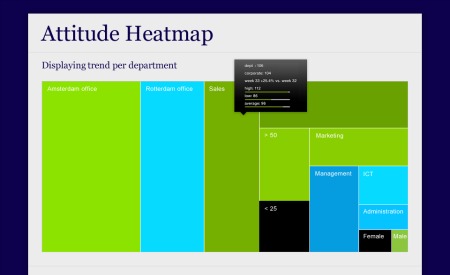
One of the most promising tools for truly measuring engagement is growing its presence in Europe and now entering the U.S. KeenCorp, headquartered in Rotterdam, the Netherlands, integrates its software with company email systems to gauge how employees feel at any given moment. Unlike surveys, it requires no effort by employees and, by layering into the company’s email system, ensures 100 percent participation.
According to Andrew Fastow, a Houston-based principal of the company, the product measures the workforce’s engagement through language analysis and tension detection. This is done by anonymizing all emails, then scanning them to measure the collective mindset of employees based on how they write. (He notes that the product is compliant with EU and U.S. privacy regulations.)
The process begins by running the KeenCorp’s software against historic email traffic. In essence, this allows the tool to create a baseline. It then scans current emails to detect pattern changes in their language. Such changes, Fastow explains, always become evident in both positive and negative messages. The software’s AI component functions in a manner that’s analogous to how the brain works when it identifies tension levels in voice inflection and body language. For example, a change in pattern might indicate rising tensions at some companies, or growing excitement at others, depending on what the baseline found.
What makes KeenCorp unique, Fastow says, is its ability to deliver critical intelligence through the capture of data that already exists, or what Microsoft calls “digital exhaust.” While that’s true, we believe another unique aspect of the product is its generation of hard data.
A former CFO himself, Fastow notes that “CFOs believe HR is a religion, not a science, because it can’t be measured.” Surveys can be less than scientific because their accuracy depends on a number of variables, including participation rates and the mood of a participant at a single moment in time. Because KeenCorp’s software is integrated into the employee’s workflow, it measures their mood on an ongoing basis, without requiring their interaction. “This results in a daily, actionable metric,” Fastow says.
What the Numbers Show
Fastow has an unusually dramatic case study to demonstrate KeenCorp’s effectiveness. If his name rings a bell, it’s probably because he’s the same Andrew Fastow who served as Enron’s CFO from 1998 through 2001, then spent six years in prison for his role in the company’s collapse.
He learned about KeenCorp when its developers asked him to help identify what they thought was a flaw in their software: Scanning several years’ worth of emails from Enron’s top 150 employees revealed a sudden and dramatic plunge in engagement on June 29, 1999. The team had been able to tie most other data movements to an event of one kind or another, but could find no explanation for this, a roughly 40-point drop that was by far the sharpest in the company’s history.

Fastow recognized the cause instantly. On June 28, Enron’s board approved the creation of LJM, a company that would acquire Enron’s poorly performing assets and thus strengthen its balance sheet. Speaking at HR.com’s INFLUENCE2018 conference in Salt Lake City last week, Fastow said that while the deal was legal, “it looked really, really bad,” and KeenCorp’s software identified executives’ concerns when the board allowed it to proceed.
After the initial plunge, Enron’s engagement numbers never returned to their previous level. “The data revealed a permanent negative impact on Enron’s culture,” Fastow told the HCM Technology Report in an interview. It picked up on something people were worried about although, as is often the case in company meetings, “no one raised their hands.”
A more typical example of KeenCorp’s usefulness occurred when one client noticed a downturn in the numbers within a particular business unit. When HR spoke to people working in the department, it discovered a manager was having an affair with a young subordinate. “The tool doesn’t identify the problem, but tells you there is a problem,” Fastow says. “It uncovers things that should be reported, but aren’t.” As a result, organizations can uncover issues and deal with them before they cost the company. “Identifying non-financial risks before they become financial liabilities” is the kind of thing that gets a CFO’s attention, he observes.
But KeenCorp’s value goes beyond heading off a crisis. It allows HR to measure in real time the effectiveness of engagement programs with far more accuracy than do traditional surveys, Fastow argues. Often, employers struggle with spreading disengagement because they can’t truly measure whether components of their programs are working or not.
By monitoring engagement as campaigns are introduced or eliminated, HR can see the impact of its efforts across the entire workforce or in designated groups. “A lot of time employees have a bad attitude because HR can’t measure what’s working and what’s not,” Fastow says. KeenCorp’s tool allows companies to see how changing attitude align with approaches to engagement.
Scratching the Surface
Although KeenCorp positions its index as a way to track engagement levels, it’s worth considering that it does so primarily by measuring tension levels as much as enthusiasm. When employees are uncomfortable, the numbers drop. When they’re enthused, they rise.
The index’s strength lies in how it can be connected relatively easily to the timing of events such as the introduction of a new benefits package or business deal. Other traditional measures come with many more caveats: “Happiness,” for example, is subjective and levels vary from individual to individual. The same level of performance feedback that engages one employee may be seen as micromanagement by another.
KeenCorp removes subjectivity by first determining what the company’s normal “tone of voice” sounds like, then tracking its rises and falls without allowing the personalities and quirks of individual employees to muddy the waters or be less than candid for whatever the reason. It also uncovers where there may be issues that employees are aware of but don’t want to discuss with their managers.
Fastow emphasizes that KeenCorp’s vision is purposely focused: “We don’t want to be a Salesforce.com or a consultant,” he says. “We want to be like ‘Intel Inside.’ We want to be a tool that the experts use to measure their impact and, ideally, we would like the KeenCorp Index to be a standard ratio in every annual report to reflect the engagement level of a company’ people.”
With six customers already launched in the U.S., Europe and Asia, the company is “just quietly building the business right now.” The tool works and “we’re ramping up,” Fastow says.
KeenCorp is worth keeping an eye on as it grows. We believe its HR applications just scratch the surface of its capabilities. “Every client comes back and says they’ve got a new way to use it,” Fastow tells us. For example, he believes the index could be used as a governance and compliance tool for chief risk officers and CFOs, as well as in the HR department.
You can learn more about KeenCorp by checking out its web site here.
Images: KeenCorp















